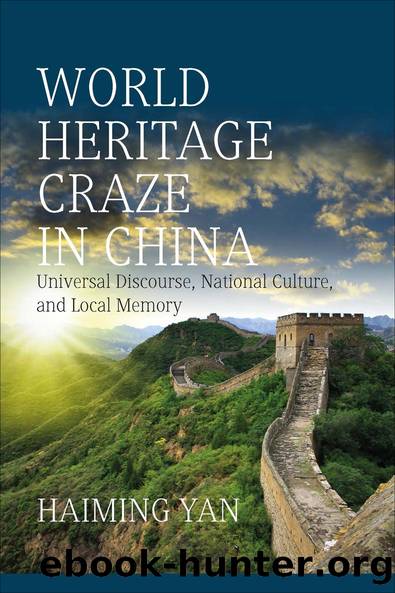World Heritage Craze in China by Haiming Yan

Author:Haiming Yan [Yan, Haiming]
Language: eng
Format: epub
ISBN: 9781785338045
Barnesnoble:
Publisher: Berghahn Books, Incorporated
Published: 2018-03-28T00:00:00+00:00
Dissonance
As demonstrated by Di Giovine (2009: 142), once a site is designated as World Heritage, it no longer belongs exclusively to locals, and the truth of this is evident in the case of Fujian Tulou. Although the lands on which the Tulou sites are situated are legally owned by the peasant collectives (SACH 2008c: 97), since World Heritage designation, practical ownership and control have become issues of great contention. This is what Tunbridge and Ashworth (1996) would term a âdissonant heritageâ and is largely associated with local politics and with power relations between the official discourse and the local community.
In Tianluokeng, most residents are now unhappy about heritage management. A villager in Tianluokeng insisted that the buildings, even the âinharmoniousâ ones, should be their own property:
But the government doesnât think so. They think it is their property. They say that human lives are an integral part of the heritage. But we are treated just as objects, not as humans. Everyone has forgotten that these are our own properties. The culture and heritage are made by us, not them. Now they sell it to the world. And we have been forgotten.
In 1999, the year when Nanjing County decided to nominate Tianluokeng for World Heritage, the residentsâ lives began to change. Their livelihood was heavily based on the cultivation of tea, but this was at stake because the formerly used tea processing buildings outside the Tulou buildings were seen to be âinharmoniousâ and were thus dismantled. The prohibition on raising domestic fowl further compounded difficulties. The originally rich fields have gradually deteriorated. As a result, dissent has become widespread: âThey [the government] think we are resources,â says a respondent. âThey just invest money and extract profits from us. But they never care about our lives and feelings!â
Before 2008, the local community would collect 20 percent of the ticket revenue, which they thought too little. In 2008, believing the buildings to be their own property, they organized themselves to make a claim for 70 percent of the ticket revenue from the countyâs bureau of tourism (Chen 2008). After their claim was rejected by the government, as the quotation at the beginning of this chapter illustrates, some residents (supported by most residents) went to the official entrance of the village and charged tourists an additional entrance fee, refusing entry to those who failed to pay. Soon, eighteen villagers were arrested and charged with âdisrupting social order.â Consequently, most families of the community have turned their backs on visitors. Although the eighteen arrested activists were eventually released, deeply anchored tensions remain. As a result, the locals do not follow any government orders, especially its requirements about commercial activities. In 2012, four years after the designation, Tianluokeng was still filled with disorganized commercial stands.
âThe key point is not ticket share,â said a villager to me. âItâs about life.â Life is strictly regulated by the harmony discourse. For example, a resident and peddler at Tianluokeng complains that he and his family are required to live in their original residence, and his expansion of the house was forcibly dismantled by the government.
Download
This site does not store any files on its server. We only index and link to content provided by other sites. Please contact the content providers to delete copyright contents if any and email us, we'll remove relevant links or contents immediately.
| Africa | Americas |
| Arctic & Antarctica | Asia |
| Australia & Oceania | Europe |
| Middle East | Russia |
| United States | World |
| Ancient Civilizations | Military |
| Historical Study & Educational Resources |
Machine Learning at Scale with H2O by Gregory Keys | David Whiting(4190)
Never by Ken Follett(3796)
Fairy Tale by Stephen King(3220)
The Man Who Died Twice by Richard Osman(2997)
Oathbringer (The Stormlight Archive, Book 3) by Brandon Sanderson(2890)
Will by Will Smith(2794)
Rationality by Steven Pinker(2291)
The Dark Hours by Michael Connelly(2246)
Can't Hurt Me: Master Your Mind and Defy the Odds - Clean Edition by David Goggins(2229)
The Dawn of Everything: A New History of Humanity by David Graeber & David Wengrow(2123)
Friends, Lovers, and the Big Terrible Thing by Matthew Perry(2123)
Principles for Dealing With the Changing World Order: Why Nations Succeed and Fail by Ray Dalio(1974)
HBR's 10 Must Reads 2022 by Harvard Business Review(1778)
A Short History of War by Jeremy Black(1763)
Go Tell the Bees That I Am Gone by Diana Gabaldon(1687)
515945210 by Unknown(1601)
A Game of Thrones (The Illustrated Edition) by George R. R. Martin(1591)
Kingdom of Ash by Maas Sarah J(1529)
443319537 by Unknown(1470)
